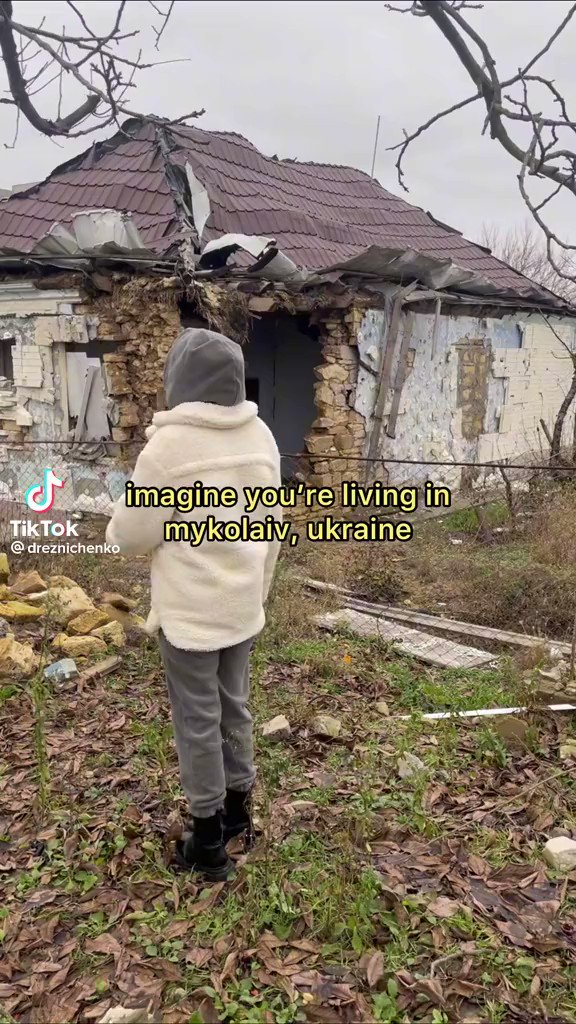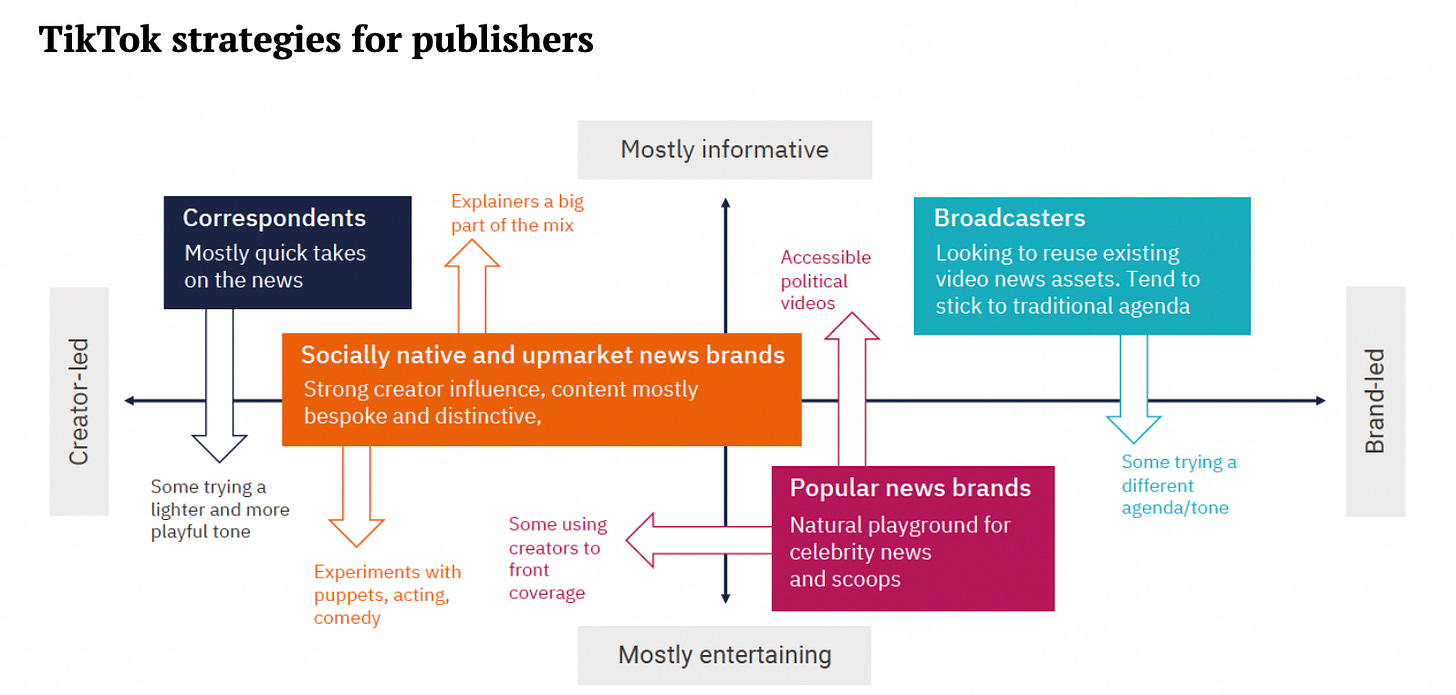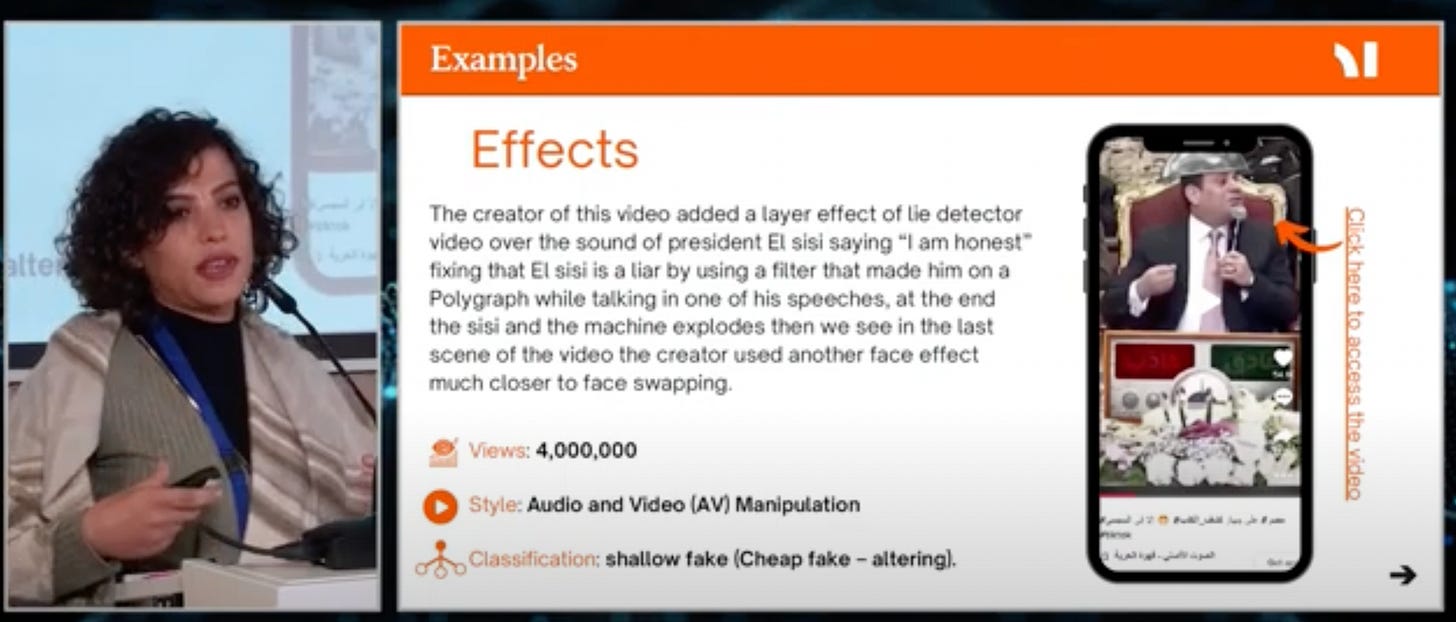Hello again.
You are reading Understanding TikTok. My name is Marcus, a TikTok researcher at HAW Hamburg. I have been on hiatus for a couple of weeks to focus on writing a book chapter, a journal article and preparing a TikTok fact checking workshop. I will talk about some of that end of May at the ICA 2023 conference. Happy to say ‘Hi’ and have a coffee if you happen to be in Toronto. Or let’s just meet next to the Niagara Falls.
Today we talk about:
🦖 What happened in the last weeks
🕵️♀️ TikTok’s Transparency Theatre
👺 Misinfo Mena
🪩 More
🦖 What happened in the last weeks
A lot. And instead of drowning you in endless links let me point you to something else. Understanding TikTok has a Discord now. Click here to join. If you are not familiar with Discord – it is an easy to use instant messaging social platform. I – and thankfully a growing number of great members – share and discuss links here. Hopefully this will turn into a little lively debate club. Meanwhile i buried @tiktoktactics.
📰 The Reuters Institute published an extensive report “How publishers are learning to create and distribute news on TikTok” in December (PDF). Among the key findings: Around half (49%) of top news publishers are now regularly publishing content on TikTok. A large proportion of these have joined TikTok in the last year.
Publisher adoption is not evenly spread. The vast majority of Indonesian (90%), Australian (89%), Spanish (86%), French (86%), and UK (81%) publishers operate active accounts on TikTok, along with more than three-quarters in the United States (US) (77%), and around two-thirds in Brazil (68%). And: There is no single recipe for success on TikTok.
🚩 Yes, we all discussed the potential of a US TikTok ban back in 2020. But here we are in February 2023 and a ban is somewhat gaining traction. TikTok is grappling with an increasingly real prospect of being banned in the United States (Vox). Here is a map by Yahoo with the states that have banned TikTok on government devices.
And here's Where It Stands (Forbes).
There are a million aspects to unwrap here. Like Banning TikTok Hurts Higher Education (Wired). And of course Members of Congress sign up for TikTok, despite security concerns (Iowa Capital Dispatch). We will know more when TikTok’s CEO will testify before Congress in March (Verge). Any by the way: TikTok Was Already In Trouble With the U.S. Now the EU Is Cracking Down (Barron’s). Brussels moves to ban Eurocrats from using TikTok (Politico). European Commission bans TikTok from staff work devices (DW).
🖼️ And then there was/is Corecore – a TikTok aesthetics trend that has been widely discussed at the beginning of 2023. Is corecore radical art or gibberish shitposts (Nobells). What Does TikTok’s “Corecore” Have to Do With Dada? (Hyperallergic). How TikTok's newest trend may be a genuine Gen-Z art form (Mashable). Corecore is the Screaming-Into-Void TikTok Trend We Deserve (Vice). Postkapitalistische Melancholie (Monopol). TikTok’s “Corecore” Is Where Men Scream Their Anguish (Hyperallergic).
🕵️♀️ TikTok’s Transparency Theatre
TikTok has a master plan to win over Washington to avoid getting banned (Vox). This plan includes Project Texas: The Details of TikTok’s Plan to Remain Operational in the United States (Lawfare). And a transparency offense including Transparency and Accountability Centers. “TikTok’s transparency center is a lot of smoke and mirrors designed to give the impression that it really cares”, writes Alex Heath for The Verge in an article with the meaningful title: TikTok’s transparency theater. “It left as many questions as it had answers”, writes Alexandra S. Levine for Forbes: TikTok Tries to Charm its Critics. Behind the scenes (Vox).
Apart from that TikTok will expand access to its research API to nonprofit academic institutions (The Verge).



After the long awaited move a first round of reactions by various researchers does not sound that promising. TikTok’s API Guidelines Are a Minefield for Researchers (Tech Policy Press). How TikTok is not “supporting independent research” (Jonathan Kemper). Researcher beware: four red flags with the TikTok API's terms of service (Sukrit Venkatagiri). Or as Joe Bak-Coleman, Associate Research Scientist @columbiajourn tweets “...incompatible with basic norms of producing rigorous and independent scientific research”.
👺 Misinfo MENA
Wafaa Heikal is Social Media Analyst at Democracy Reporting International. She presented at #DisinfoCon (video) in December with her research on TikTok and disinformation with a focus on Synthetic Media in the MENA region – an acronym referring to a grouping of countries situated in and around the Middle East and North Africa. I was particularly interested in TikTok’s relevance in the region and the usage of synthetic media having covered Deepfakes in #89 so we mailed.
Concerning TikTok’s relevance in the MENA region – Could you give us a short overview? What do we know about users, topics, and politicians/media on the platform?
TikTok is booming in the Middle East, with numbers estimated to be 20.28 million users aged 18 and above in Egypt in early February 2022. Numbers are estimated to be 22.37 million users aged 18 and above in Saudi Arabia in early February 2022. Turkey has roughly 26.6 million TikTok users.
Although TikTok Trends has been covered heavily by TV and media, we don’t witness many initiatives using TikTok to create informative content on TikTok targeting youth and teens outside the topics of entertainment. We still don’t see many politicians using TikTok, although there’s no shortage of political content. All these insights need more research and documentation.
What does synthetic media mean and what kind of synthetic media have you observed on TikTok?
Synthetic media means any form of media generated by AI, including video, audio, or image and text.
The use of deep fake technology in MENA varies between cheap fakes, synthetic media, audio, and video manipulation, and deep fakes. Different formats use different technology to spread political narratives, and most synthetic media I observed were cheap fake and audio video manipulation.
Deepfake content can be used as means to support the exercise of freedom of speech and expression through creative forms such as satire. It can also be used to fabricate incriminating or distressing content used in targeting individuals and spreading disinformation and hate speech.
Could you please give us an example of a shallow fake? And a deep fake?
Shallow Fake depends on using shells or visual templates to create cheap and quick videos using image-editing software.
Deepfake is used as an umbrella term to cover all forms of audiovisual manipulation, although strictly speaking, deepfakes are highly sophisticated manipulation of audiovisual media using AI-driven technology. This term comes from merging “deep learning” with “fake”.
The spectrum of cheap fake and deep fake is something I like to refer to, you will notice that they both use the same techniques of manipulation like Face Swapping, but they differ in the expertise and technical resources used.
Data & Society — Deepfakes and Cheap Fakes (datasociety.net)
Which one is more dangerous?
I think the sophistication of Deepfakes technology in spreading disinformation is scary, but I don’t think it is the most important element here. I think cheap fake can be dangerous too if we take into consideration, its nature of being re-mixed, crossing borders easily, and adapting to different cultures. Internet users are still exposed to cheaper fake disinformation than deep fake, as cheap fake software is easy to access and free to download. We need to develop solutions for our real-time problems while we are keeping an eye on the emerging threats and dangers of the future. We at Democracry Reporting International work with regional partners in Jordan, Tunis, Lebanon, and Sudan to develop solutions for current disinformation threats through our "Words Matter" project. At DRI we also keeping an eye on the emerging threats and dangers of the future through our work at DisinfoRadar.
Thanks a lot Wafaa!🪩 More
Last summer, 1,704 TikTok accounts made a coordinated and covert effort to influence public discourse about the war in Ukraine, the company said (New York Times).
POV: you fled Ukraine (The Face)
TikTok is crushing YouTube in annual study of kids’ and teens’ app usage (TechCrunch)
Migrants and asylum seekers in Ireland at risk as a result of trending TikTok videos (ISD)
TikTok incentivizes content creators to post longer videos with new monetization program (Phone Arena)
TikTok is testing a way to reset your For You page (The Verge)
Why Do People Believe Everything They Watch on TikTok? (Vice)
How the first impartial LGBTQ+ news brand gathered almost 140,000 followers on TikTok (Reuters Institute)
I spent all night on TikTok Live (Insider)
Speak soon. And do not forget.







